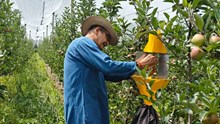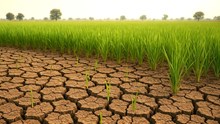
As we approach World Bee Day 2025, the significance of bees in maintaining biodiversity and food security is more relevant than ever. This year, under the theme “Bee inspired by nature to nourish us all” we honor the incredible contributions of bees to our ecosystems, and one of their most beneficial byproducts, beeswax, has become increasingly popular as a sustainable alternative to plastic. Among the many uses of beeswax, beeswax wraps stand out as an eco-friendly solution for food storage.
This growing demand for beeswax presents a unique opportunity for farmers to consider honey bee farming as a sustainable venture. By engaging in bee farming, farmers can contribute to biodiversity, support local ecosystems, and tap into the rising market for beeswax-based products like beeswax wraps, all while benefiting from honey production. This is a good chance to diversify farm income while playing a vital role in preserving our environment.
What Are Beeswax Wraps?
Beeswax wraps are created by infusing cotton fabric with a mixture of beeswax, jojoba oil, and tree resin. This blend results in a flexible, slightly tacky material that can be molded around food items or containers to create a breathable seal. Unlike plastic wraps, beeswax wraps are reusable, biodegradable, and completely natural, making them a sustainable option for anyone looking to reduce their carbon footprint.
The wraps come in various sizes, and the soft, pliable texture allows them to wrap around fruits, vegetables, bread, cheese, and other foods, providing a breathable covering that helps extend freshness. The wax coating also imparts antibacterial properties, ensuring that the food stays fresh longer. The wraps are also naturally water-resistant, preventing moisture from seeping in, which is especially useful for items like sandwiches or cut fruits.
Uses of Beeswax Wraps
Beeswax wraps have several practical uses beyond traditional food storage. Thanks to their versatile and moldable nature, these wraps can be adapted for various purposes:
-
Food Storage: The most common use for beeswax wraps is storing food. Whether it's wrapping a block of cheese or covering a bowl of leftovers, beeswax wraps provide a natural way to preserve food. The breathable material ensures that fruits and vegetables don’t sweat or rot, maintaining their texture and taste for longer periods.
-
Packing Snacks: Beeswax wraps are an excellent alternative to plastic bags when packing snacks for lunch or travel. You can use them to wrap fruit, nuts, or sandwiches, providing a compact and eco-friendly solution for on-the-go eating.
-
Covering Bowls: Beeswax wraps can be used as a cover for bowls, serving as an alternative to plastic lids or aluminum foil. The wraps mold to the shape of the container, providing a secure seal to protect your food.
-
Creative Uses: In addition to food storage, beeswax wraps can be shaped into other useful items. You can create funnels, make a pouch for small items, or even use them as a substitute for a lid when baking. The moldable nature of the wrap opens up many possibilities for creative uses in the kitchen.
Benefits of Beeswax Wraps
The environmental benefits of using beeswax wraps are numerous. First and foremost, they help reduce the need for single-use plastics. Traditional plastic wraps contribute significantly to plastic pollution, but beeswax wraps offer a sustainable, reusable alternative. This makes them an essential item for anyone looking to reduce waste and adopt a more eco-friendly lifestyle.
Beeswax wraps are also compostable, meaning they won’t contribute to landfill waste at the end of their lifespan. Once they have reached the end of their useful life, they can be composted, ensuring that they decompose naturally without leaving harmful residues behind.
Additionally, beeswax wraps are free from harmful chemicals often found in plastic wraps, such as BPA or phthalates, making them a safer choice for food storage, particularly for families with young children.
How to Care for Beeswax Wraps
Proper care is essential to extend the life of your beeswax wraps. Fortunately, maintaining them is simple. After each use, beeswax wraps can be washed with cold water and mild soap. Avoid using hot water, as it can melt the wax coating. Once cleaned, the wraps should be air-dried before being stored for the next use. With proper care, a beeswax wrap can last up to a year. When the wrap becomes less effective, it can be composted, as it is made from entirely natural materials.
Beeswax Wraps: Sustainability at Its Best
The production of beeswax wraps aligns with sustainable practices. Beeswax is a byproduct of the honey extraction process, where wax caps are removed from honeycombs. This means that the wax used in the wraps comes from a renewable source, and the process of making beeswax wraps creates minimal waste. The other ingredients, such as jojoba oil and tree resin, are natural and non-toxic, making them a safe option for both the environment and human health.
By choosing beeswax wraps, consumers are supporting a circular economy. These wraps are reusable, and at the end of their life cycle, they decompose naturally, contributing to zero-waste practices.
Potential Drawbacks
While beeswax wraps offer a host of benefits, they are not without some limitations. One downside is the initial cost. Beeswax wraps tend to be more expensive than single-use plastic wraps, which may be a consideration for those on a budget. Additionally, while they are versatile, beeswax wraps are not suitable for all foods. They are not ideal for wrapping raw meats or highly moist foods, as these items can compromise the integrity of the wrap and make it harder to clean.
Moreover, beeswax wraps require regular care to maintain their effectiveness. Unlike plastic wraps, which are simply discarded after use, beeswax wraps need to be washed and maintained. For those who are used to disposable solutions, this may seem like an inconvenience.
This World Bee Day 2025, let’s recognize bees' vital role beyond honey—supporting sustainability through products like beeswax wraps. By using them, we reduce plastic waste, support eco-friendly practices, and honor bees’ hard work. Embracing such alternatives helps protect the environment and promotes sustainable living. Incorporating beeswax wraps into daily routines is a simple yet impactful way to reduce waste and ensure bees continue to thrive in the natural world.















